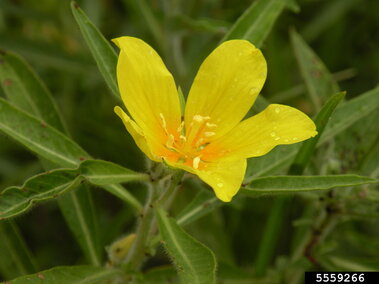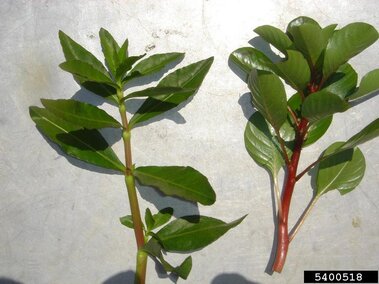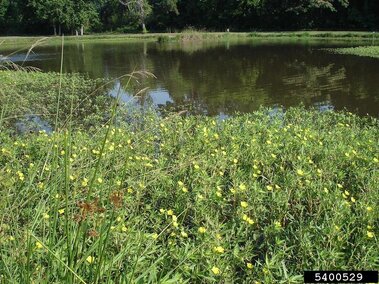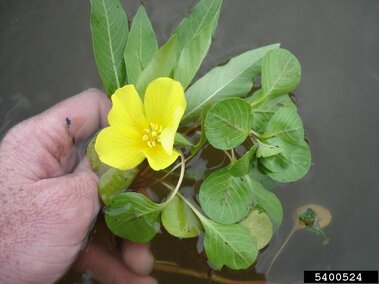General Information
Species Name: Ludwigia peploides
Also Known As: floating primrose willow, floating water primrose, water primrose
Family: Onagraceae (Evening Primrose)
Growth Form: Forb (floating aquatic)
Life Span: Perennial
Flowering Dates: April to October
Origin: Australia, New Zealand, North America, South America
Noxious: No, but berries may be mildly poisonous if eaten.
Category 2: Priority Aquatic Invasive Species
Why Is It Invasive?
Creeping water primrose forms dense, fast-growing, floating mats that can restrict fishing and boating access, displace native aquatic plants and wetland grasses, and reduce water quality for wildlife and increase sedimentation. The plant also has allelopathic abilities that can alter the oxygen levels in the water, leading to crashes and detrimental changes in the sulfide and phosphate compounds in the water.
What Does It Look Like?
General Characteristics
Creeping water primrose is a perennial herbaceous plant of wetlands whose sprawling stems usually grow flat along mud or the surface of the water.
Flowers
Solitary flowers are held on stems arising from the upper leaf axils. Stems can be floating or lying on the ground. Flowers have five bright notched yellow petals, 0.4-0.6 in. (1-1.5 cm) long.
Leaves
Leaves are hairless, glossy and dark green with a light green central midrib, and vary in shape and size, from lanceolate to ovate, but are often spoon shaped, with smooth margins. Leaves are alternately arranged. They range from 0.5-4 in. (1.27-10.2 cm) long. Leaf petioles range from 1-1.5 in. (2.5-3.8 cm) long.
Stems
Stems are fleshy and red, floating or creeping, sometimes ascending to erect, from a few inches long up to about 10 feet long. Its glabrous stems creep horizontally and vertically across and through the mud and water, often ending in what looks like a rosette
Seeds
Fruits are glabrous to sparsely hairy cylindrical capsules that contain many small seeds about 0.04 in. (1 mm) in size.
Photos
Where Does It Grow?
Creeping water primrose grows in wet terrestrial areas and freshwater aquatic areas. Given its hardiness, this plant can grow in dams, trenches, ditches, and canals. The ideal habitat for this plant is in 2-3 m deep water, with little to no current, such as marshes, ponds, slow-moving rivers, and shorelines. Typically, the plant will begin its growth on the water’s bank and extend out horizontally into deeper waters. It can grow in a variety of substrates, including sandy and gravely soils. It can tolerate both wet and dry climates; however, it will spread easier under wet conditions. It is relatively tolerant to frost.
How Does It Spread?
Creeping water primrose was introduced from the Americas to Montpellier in France in the 1830s. It is now often spread through the gardening and aqua-scaping trade as an ornamental plant.
How Do I Control It?
Management of invasive aquatic plants involving either mechanical removal of plants or application of herbicides to public waters requires a permit. Contact the Contact the Nebraska Game and Parks Commission for more information.
Mechanical
Cutting or pulling the plant by hand or with equipment such as rakes or cutting blades could break it into fragments, allowing it to further spread. Contact the Nebraska Game and Parks Commission to determine appropriate removal methods.
Cultural
CLEAN your watercraft, trailer, angling gear and other equipment. Remove all aquatic vegetation and animal species from your equipment.
DRAIN your watercraft at the ramp by removing the boat plug and draining all live wells and ballast tanks.
DRY your watercraft, trailer and other equipment for at least 7 days before visiting another waterbody.
DON'T LET IT LOOSE. Do not release or transport exotic or non-native fish species to new ecosystems, and do not dump aquariums. It is unlawful to release any aquatic species into a waterbody other than the one from which it was harvested. Doing so can promote the spread of AIS.
Chemical
Application of chemicals to public waters requires a permit. Contact the Contact the Nebraska Game and Parks Commission for more information.
What Should I Do If I See It in Nebraska?
If you see creeping water primrose in Nebraska, you should report it to the Nebraska Game and Parks Commission's Aquatic Invasive Species (AIS) Program using their AIS Report Form. For guidance on what information to include in your report, check out our reporting tips.
References and More Information
California Invasive Plant Council
Center for Invasive Species and Ecosystem Health
Lady Bird Johnson Wildflower Center
Long Island Invasive Species Management Area
Michigan Invasive Species Program








